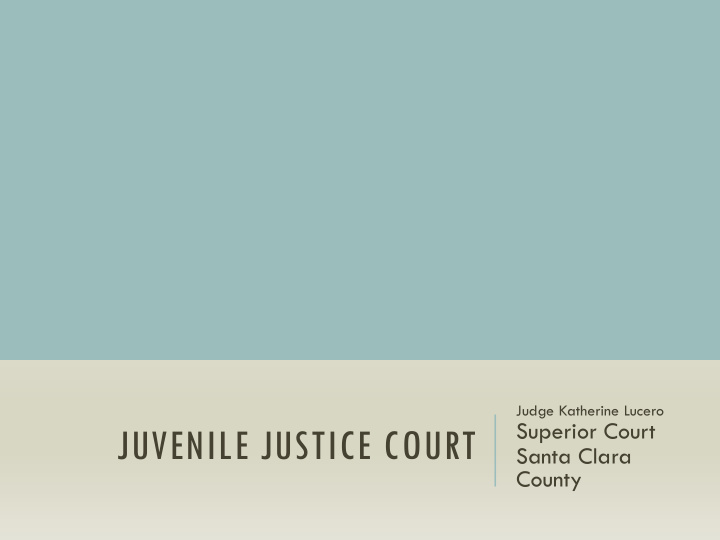



Judge Katherine Lucero Superior Court JUVENILE JUSTICE COURT Santa Clara County
The Typical Life of a Case Arrest of citation Diversion options Contested Hearings Jurisdiction Disposition Custody, EMP , CRP , PSW, Fines and Fees Restitution Reviews Dismissal/Sealing
Adolescent Brain Development In Miller , Justice Elena Kagan’s majority opinion she notes, we cannot “preclude consideration of chronological age and its hallmark features – among them, immaturity, impetuosity, and failure to appreciate risks and consequences .” 3
GIRLS ARE DIFFERENT 50% of girls statewide identify as LBGT-GNC Sexual Assault to Prison Pipeline Relationships matter Mother-daughter fractured relationships Education is critical for rehabilitation. Young Women’s Freedom Center
Recent Law Changes Direct Files no longer permitted All hearings now called Transfer Hearings Juvenile Miranda Prosecution of kids under 12 Direct File for 14 and 15 year olds
Gangs and Juvenile Justice Court Many youth not yet “jumped” in, however they associate. Many youth feel they must join to be safe and protected in their neighborhoods. Many youth want to have a different life but do not know how and do not have the support they need to leave the gang directed path. No gang unit at JPD: Many gang diversion programs.
Access to Justice for Multi-Court and Multi-System families The real work of the Juvenile Court Judge is to rehabilitate the youth and keep society safe. And it is keeping society safe when we focus on rehabilitation.
Juvenile Court Judge as Resource Developer California Standards of Judicial Administration Provide active leadership within the community in determining the needs of and obtaining and developing resources and services for at-risk children and families. At-risk youth include delinquents, dependents and status offenders.
COURT AS ONE PART OF A SYSTEM JUDGE AS DIRECTOR Superior Court as the Umbrella Department of Probation Educational System Drug and Alcohol Services Department Mental Health Department Department of Corrections Families involved in more than one court at a time: Child Welfare, Criminal , Probate, Family FIRST 5 of Santa Clara County Medical Care, Immigration, Housing Department
Disproportionality in Juvenile Justice SANTA CLARA COUNTY (consistent with national and regional data re: AA youth) 85% of incarcerated youth are Latino Latino Children are 33% of SCC population 18% of incarcerated are African American African American Children are 3% of SCC population
Who is in Court? Youth age 12 to 18 Almost 90% of the kids in court are disengaged with or failing in school. Middle School is critical for youth to feel successful and competent. Transition to high school is where I see we lose kids. Marijuana use is high.
YOUTH IN THE JUVENILE JUSTICE SYSTEM Sex and Age of Youth Arrested • 77% of youth arrested were male. Behavioral Health • 57% of youth arrested were 16 and 30% of girls attempted or thought older. Home Life • 32% were 14 & 15 years old. about committing suicide versus • The zip codes where most youth • 11% were 13 years old and younger. 11% of boys. reside include 95122, 95116 and 70% of girls and 62% of boys had 95020 (19% total). significant issues with depression, Girls had less parental supervision anxiety, and other emotional (41%) compared to boys (29%). factors. Criminogenic Needs Child Abuse and Neglect For boys, Criminal Orientation • 55% of youth had at least one was higher (26%) compared to referral as the alleged victim. Education girls (14%). Girls (35%) self-reported more Just over 40% of boys and girls For boys, School Inadequacy was higher abuse/neglect and trauma had anti-social peers. (35%) compared to girls (25%). compared to boys (18%). Issues due to lack of intellectual capacity (boys 19%, girls 14%) and due to achievement problems (boys 36%, girls 31%). 12
SOCIAL MEDIA ISSUES 1. Social Pressure heightened due to social media platforms- causes anxiety for youth 2. Lots of “evidence” on phones that ends up in court (Instagram posts of “loot” and gun play, sexting and revenge porn) 3. Bullying online 4. Meeting up for crimes
2017-2019 JUVENILE CRIME TRENDS
Foster ED Program at JPD Education is viewed as the key pro-social activity that youth can be linked to in order to take them off the pipeline to prison- - Automatic Educational Screenings - Youth referred to Foster Ed Liaison, Project YEA or LACY - Family Member identified and trained up as the Ed Champion
When necessary, legal representation is available for Educational Rights and Immigration issues to eliminate legal barriers. As a result, youth feel safe and welcomed at school and in their community which would lead to school and community investment and success.
Recommend
More recommend